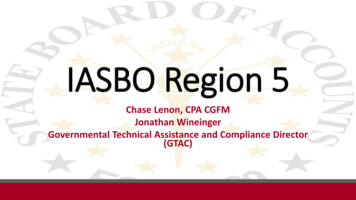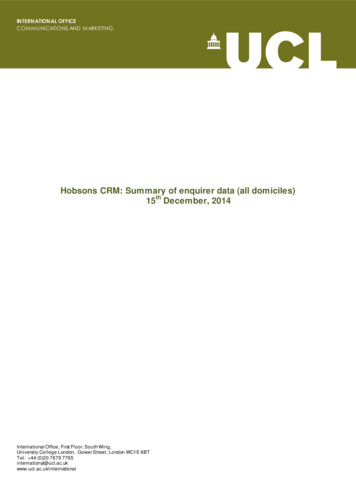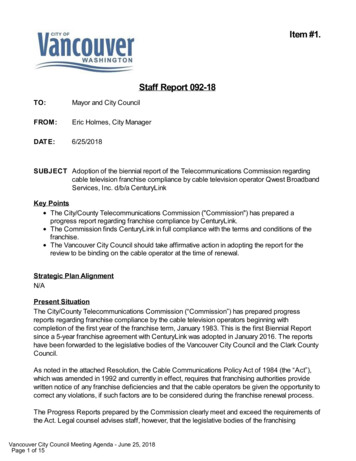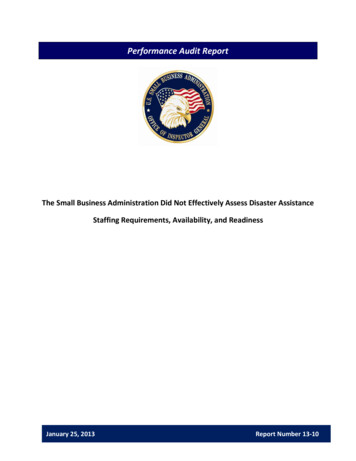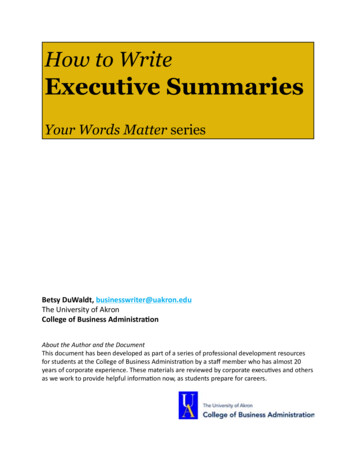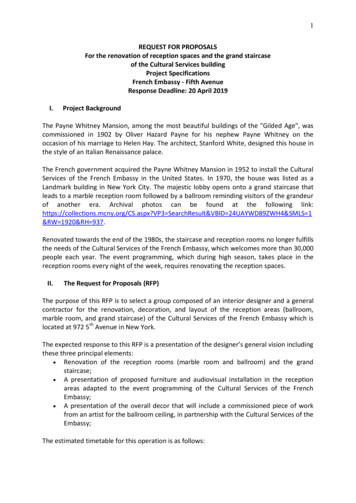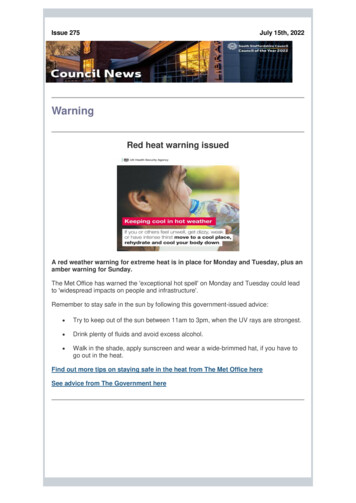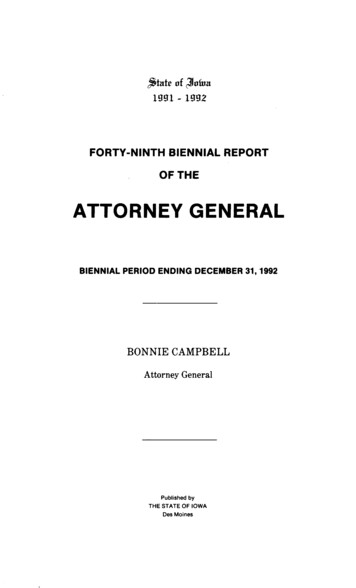
Transcription
15th Biennial ReportExecutive Summary& Recommendations
Fifteenth Biennial ReportPrepared pursuant to the Great Lakes Water Quality Agreement of 1978 for submission to the Governmentsof the United states and Canada and the State and Provincial Governments of the Great Lakes Basin.CommissionersLana PollackJoseph ComuzziIrene B. BrooksPierre TrépanierSam SpeckLyall D. KnottInternational Joint Commission officesCanadian Section234 Laurier Avenue, W.22nd FloorOttawa, Ontario K1P 6K6(613) 995-2984commission @ottawa.ijc.orgUnited States Section2000 “L” Street NW, Suite 615Washington, D.C. 20440(202) 736-9000commission@washington.ijc.orgGreat Lakes Regional OfficePhoto Credits:Jim Nies, Oceaxe@sbcglobal.netKalmin Csia, Southwest Michigan Land ConservancyDreamstime.com100 Ouellette Avenue, 8th FloorWindsor, Ontario N9A 6T3(519) 257-6700commission@windsor.ijc.orgorP.O Box 32869Detroit, Michigan 48232(313) 226-2170www.ijc.org
Dear Friend of the Great Lakes:The United States and Canada are extraordinarilyfortunate to share the Great Lakes, a world-classresource containing one-fifth of all the fresh surfacewater on earth. The importance of this internationaltreasure was recognized nearly 40 years ago when theUnited States and Canada first signed the Great LakesWater Quality Agreement (Agreement) thatcommitted our two countries to restore and maintain the chemical, physical and biological integrity ofthe waters of the Great Lakes Basin Ecosystem. Anupdated agreement is now being negotiated, providinga unique opportunity to set new goals that will guidefuture actions to protect and restore this vital asset.The International Joint Commission (Commission)is charged with preparing a report to the federal, stateand provincial governments that assesses progress tomeet Agreement objectives. Our Fifteenth BiennialReport provides 32 recommendations for action atthe federal, state, provincial and local levels ofgovernment. In particular, the recommendations focuson the need for the United States and Canada toapprove an updated Agreement that addresses threatsto water quality in order to prevent or reduce theirimpact on human and ecological health. These threatsare of greatest concern in the nearshore zone wherepeople interact with the lakes and include beachclosings, harmful algal growth, contaminatedgroundwater and alien invasive species.We believe that the report will also help legislaturesensure that resources are effectively directed toaddressing the highest-priority challenges. Highlightsof the recommendations follow this letter and a fulllist is appended to this executive summary. Completecopies of the report are available online at www.ijc.orgor may be requested from a Commission office.Sincerely,Lana PollackU.S. Co-Chair1Joseph ComuzziCanadian Co-Chair
15th Biennial ReportHighlights of RecommendationsResearch and Monitoringmanagers improve their understanding of eutrophicationand select the wisest management actions.A key concern raised in the report is the resurgenceof eutrophication–aquatic plant growth caused byexcessive nutrients such as phosphorus. Among manypotential causes identified in the report, key factors arebelieved to be inadequate municipal wastewater andresidential septic systems, agricultural run-off,industrial livestock operations and the impacts ofclimate change, which causes more frequent andintense precipitation and stormwater events. Toaddress this challenge, the report recommends newresearch and monitoring efforts similar to theCommission’s Pollution from Land-use ActivitiesReference Group (PLUARG) in the 1970s.The report also cites the impact of nonpoint source pollution on water quality at recreational beaches and recommends federal support into research to improve indicators of threats to human health. Such new indicators,better warning systems for the public, and a binationalstandardized system of surveillance and monitoring arerecommended to protect public health and reduce beachclosings. Related recommendations in the report includesystematic basin-wide collection of groundwater qualityand quantity data, monitoring for chemicals of emergingconcern, such as pharmaceuticals and personal careproducts, and research into their health effects as wellas into treatment systems to remove them fromdrinking water.The largest ever study of pollution in the Great Lakesfrom land-use activities such as agriculture and forestryoperations, PLUARG research was instrumental indetermining the regulatory actions needed to addressnonpoint source pollution. PLUARG II would help2
GovernanceThe report notes that while collaboration has improvedin recent years, there is a critical need to modifyexisting governance to strengthen coordination acrossjurisdictional lines to address ecological challengesin the nearshore. Specifically, the Commissionrecommends adopting Lakewide Management Plans(LaMPs) as the geographic unit to coordinate,integrate and implement programs to address theimpacts of agricultural and urban areas on waterquality. Currently, LaMPs include all thegovernmental, nongovernmental and tribal/firstnation units in coordinating ecological restorationprojects and also engage the public.With the Asian Carp threatening to invade the GreatLakes, the report recommends using a revised GreatLakes Water Quality Agreement as a vehicle for thedevelopment and deployment of binational protocolsfor rapid response before invasive species enter thelakes. The report also calls for binational coordinationto develop consistent fish consumption advisories.Regulatory Actionand Public InfrastructureThe report recommends that governments institute“no regrets” actions immediately to reduce nonpointsources of pollution from agricultural and urbansources, especially in phosphorus-sensitive watershedsas well as from point sources, such as sewage treatmentplants. In addition, the Commission recommendsimproved enforcement efforts to preventcontamination of groundwater, establishment ofstandards and regular inspections for septic systemsand more effective regulations of confined animal3feeding operations to ensure proper treatment ofmanure and application of methods to reduce run-off.Note: The complete report is available at www.ijc.org.In particular, therecommendations focuson the need for theUnited States and Canadato approve an updatedGreat Lakes WaterQuality Agreement thataddresses threats to waterquality in order to preventor reduce their impact onhuman and ecologicalhealth.
Executive SummaryArticle VII of the Canada-United States Great LakesWater Quality Agreement (Agreement) requires theInternational Joint Commission to report bienniallyto the Parties and to state and provincial governmentsconcerning progress toward achieving Agreementobjectives, and the effectiveness of programs pursuantto it. Article VII also directs the Commission toprovide advice on any matter related to the quality ofthe boundary waters of the Great Lakes system.The focus of this report is the nearshore zone, the vitalecological link between watersheds, tributaries,wetlands, groundwater, and offshore waters of theGreat Lakes. Most people live in the nearshore andget their drinking water from this zone. The nearshorealso supports critical habitat for fish, invertebrate andwildlife populations. Beach closings, nuisance algalgrowth, the establishment of alien invasive species, andhabitat loss are just some of the troublesomedevelopments in the nearshore that act as harbingersof future changes in offshore waters. A revisedAgreement should be strengthened with explicitprovisions to address threats to nearshore waterquality and to prevent or reduce their impact onhuman and ecological health.In this 15th Biennial Report, the Commissionaddresses issues that are relevant to governmentdepartments and agencies at all levels along with otherorganizations with environmental responsibilities inthe Great Lakes basin. These issues are particularlypertinent given the current negotiations betweenCanada and the United States to revise the Agreement.This document is based on the reports of work groupsestablished by our advisory boards with additionalinput provided by commissioners and staff.In a December 2007 letter to governments, theCommission concluded that water qualityproblems in nearshore areas have binationalimplications and binational cooperation is required4
to solve them. The Commission noted that urban andagricultural nonpoint pollution are key contributorsto excessive loadings of phosphorus and need to bereduced; nutrient-control programs need to be fundedand implemented; most programs to monitorphosphorus loadings terminated fifteen years agoneed to be reinstated; and the significant gaps inunderstanding linkages between land sources,nearshore, and offshore waters need to be addressed.The Commission recognizes the need for betteraccountability measures and integration of servicesamong the many levels of government and governmentagencies charged with protecting the Great Lakes basinin both countries. Triennial reports, as recommendedby the Commission in its 2006 advice to governmentsabout their review of the Agreement, should bemandated to include an evaluation of the policiesand programs in both countries that are intended tofulfill the governmental obligations stipulated in theAgreement.Lakes. Coordination and collaboration amongbinational institutions on nearshore zone issueshave improved in recent years, but they must befurther enhanced.Greater attention must be devoted to addressing theimpacts of agricultural and urban areas on Great Lakeswater quality. Because the permitting and budgetaryresponsibility for urban development and agriculturalpractices is shared among all orders of government,the Commission recommends using LakewideManagement Plans (LaMPs)1 as the geographic unitto coordinate, integrate, and implement programs.All levels of government, watershed and otherenvironmental non-governmental organizations shouldbe involved in each LaMP. A binational conditionassessment needs to be performed to establish abaseline that roughly coincides with the timing of therevised Agreement. Within watersheds, an assessmentof stressors should be undertaken prior to usinganalytical and diagnostic tools to assess causes ofproblems and determining management actions.A Nearshore FrameworkProper management of the nearshore requires adaptivemanagement and improved governance along withmanagement and planning at a scale that integrateswatersheds with their associated lake. The Commissionbelieves that existing governance structures could bemodified to meet these challenges.For the most part, jurisdictions and institutions are notaligned with the hydrological boundaries of the GreatLakes basin. There are multiple levels of government intwo countries, bi-national organizations, andenvironmental nongovernmental associations withdiverse legislative, programmatic, and policy tools–andall are addressing water-quality problems in the Great5A Lakewide Management Plan, or “LaMP”, is a plan of action toassess, restore, protect and monitor the ecosystem health of a GreatLake. It is used to coordinate the work of all the government, tribal,and non-government partners working to improve the Lakeecosystem. A public consultation process is used to ensure that theLaMP is addressing the public’s concerns. (EPA, 2008)1
EutrophicationThe Commission is troubled by nearshoreeutrophication, aquatic plant growth caused byexcessive nutrients, which causes adverse effects onecosystems, the economy, recreation, and humanhealth. The reemergence of algal blooms is likely dueto multiple factors, including inadequate municipalwastewater and residential septic systems; runoff fromincreased impervious surface areas and agriculturalrow-crop areas; discharges from tile drainage whichresult in more dissolved reactive phosphorus loading;industrial livestock operations; ecosystem changesfrom invasive mussel species; and impacts from climatechange which include warmer water and more frequentand intense precipitation and stormwater events.oligotrophication (nutrient depletion) of the offshore.The Commission recommends accomplishing thenecessary monitoring and research actions via a majorbinational scientific effort similar to the Commission’sPollution from Land Use Activities Reference Group(PLUARG) of the 1970s. PLUARG produced a bodyof work instrumental in understanding and addressingnonpoint source pollution. A “PLUARG II” wouldimprove the understanding of the resurgence ofeutrophication and help managers select the wisestmanagement actions.In the interim, the Commission recommends thatall levels of government implement actions to reducenonpoint sources from agricultural and urbanizedwatershed and tributaries. The Commissionrecommends governments place priority on theprotection and restoration of wetlands and forest landsto enhance the quality and resiliency of the GreatLakes ecosystem. These habitats are naturally effectiveat filtering and reducing some pollutants that affectnearshore water quality. Governments should exerciseavailable options to prevent conversion of existinghabitats to uses that could damage water quality orfish and wildlife populations, and restore habitatsthrough conservation easements or public ownershipof habitats.As a result, more coordinated and frequentmonitoring of algal fouling is needed as is watershedspecific monitoring to test both causal hypotheses andassess management actions. More sophisticated modelsare needed to capture the interactions of habitat, fishcommunity structure, and nutrient loading and workmust be undertaken to understand the linkage ofnearshore re- emergence of eutrophication andIn addition, the Commission recommends actionsthat mimic natural processes such as buffer strips onagricultural land, rain gardens and green roofs inurban areas, along with reducing urban sprawl andimpervious surfaces. All these efforts need to beundertaken in nearshore and in all tributarywatersheds. Effective efforts need to be documented6
and shared among potential users. In the longer term,there is a need to further develop systems that usephosphorus for desirable outcomes, such as harvestingalgal biomass for biofuel.Beaches and RecreationalWater QualityBeaches and recreational waters are critical to theeconomic and environmental health of the Great Lakesregion and to the quality of life for residents andvisitors. They provide recreational opportunities andcontribute to ecosystem biodiversity and providebreeding grounds and cover for fish, birds, aquaticinvertebrates and other wildlife.Nonpoint source pollution, in particular urban andagricultural stormwater runoff, poses a much greaterthreat to recreational water bodies than point sourcepollution. More frequent and severe storm events,predicted by models of climate change, will haveadditional impacts.The presence of E. coli bacteria and other pathogensin surface water can serve as an indicator of bacterialcontamination. Nevertheless, testing can produce falsepositive results when fecal indicator bacteria frombirds, algae and other natural populations, whichhave less pathogenic bacteria, are mistaken for humanfecal contamination. The Commission recommendsthe federal governments support research into novelindicators of human fecal contamination to determinerapidly the risk to human health and increase theefficiency of decision-making for beach advisories. TheCommission further recommends that governmentsshare information on causes and best practices toimprove water quality, enhance warning systems, andreduce the need for beach closings.7An efficient and timely testing method is needed toadvise the public about recreational water quality.Current beach testing methodologies take 24 hours ormore prior to posting beaches as unsafe for swimming.The Commission recommends that state and localgovernments improve public communications andissue preemptive advisories where a correlationbetween rainfall and elevated bacteria levels exist orwhen sewer overflows or other catastrophic eventsjeopardize public health.Under a revised Agreement, there should be binationaland nearshore standardized basin-wide surveillanceand monitoring protocols along with standardizedcriteria for beach postings. Further, the Commissionrecommends that both governments designate a leadagency to establish a binational, systematic, centralized,consistent, and timely way to evaluate and reportwaterborne illness in the Great Lakes and to facilitatecollaboration on best practices at all levels ofgovernment.GroundwaterGroundwater recharges streams and rivers that flowinto lakes, contributes to fish habitat, and supportssignificant ecosystem functions by maintaining streamflows and wetlands during dry periods. Groundwater’scontribution to Great Lakes tributaries ranges from48 percent in the Lake Erie basin to 79 percent in theLake Michigan basin. In addition, an estimated 8.2million people, 82 percent of the rural population, relyon groundwater for drinking water. Groundwater inthe Great Lakes basin is of generally good quality butis threatened by chemical and biological inputs frompoint and nonpoint sources.
Annex 16 of the Agreement calls for both federalgovernments, in cooperation with state and provincialgovernments, to identify and control the sourcesgroundwater contamination and to issue biennialprogress reports to the Commission. This work hasnot been accomplished.veterinary and human pharmaceuticals, flameretardants, and phthalates used to make plastic flexible.Wastewater treatment plants, one of the leadingconveyors of these chemicals to the nearshore, are notdesigned to remove them.While the Agreement has annexes that address toxicsubstances, none mention chemicals of emerging concern. A revised Agreement should includeprovisions to address this shortcoming. This revisionshould include the underlying principles and processesby which the Parties would prioritize categories ofchemicals to address, rather than compiling a long listof specific chemicals which would rapidly becomeoutdated. There is a need to establish coordinatedmonitoring programs that will provide exposure andeffects information. An easily accessible repository fordata also needs to be established by the governments toenable assessment of management options.In 2010, Commission boards published a reportdescribing a range of specific threats to groundwater.The report recommended actions that could be takenby all levels of government, including research,monitoring, regulation, enforcement and economicand tax incentives. Specific threats to groundwater inthe basin include: pathogens, toxic chemicals,nutrients, household products, hormones, antibiotics,pharmaceuticals, and road salt. The sources of thesethreats include: failing septic systems, leakingunderground storage tanks, hazardous waste sites,abandoned wells, leaking sanitary sewers, confinedanimal feeding operations, de-icing practices, landfills,land application of manure, agricultural practices,spills, atmospheric deposition, vehicle fluids,cemeteries, petroleum refineries, and injection wells.In addition, the Commission recommends that thegovernments provide incentives and educationalprograms to encourage industry, agriculture, andconsumers to develop and use environmentally-friendlyalternative products, thereby reducing the productionand consumption of chemicals of emerging concern.A revised Agreement should strengthen theprovisions of Annex 16 by incorporating some ofthese recommendations to spur implementation.In particular, efforts are needed by all levels ofgovernment to address leaking septic tanks andunderground storage tanks as well as runoff fromconfined animal feeding operations.Chemicals of Emerging ConcernThe term “chemicals of emerging concern” refers tothe recently recognized risk to human health andecosystems from some unregulated or inadequatelyregulated chemicals. These chemicals are found incommon household and personal care products,8
Fish ConsumptionMost attention to Great Lakes fish consumption isfocused on risks because contaminant levels in manyspecies exceed current health standards. Nevertheless,fish consumption is beneficial for health because theyprovide a dietary source of high-quality protein andomega-3 fatty acids. The risk/benefit tradeoff of GreatLakes fish consumption is further complicated becausemost assessments of health benefits are based onanalyses of marine fish.Diverse health impacts from some chemicals are welldocumented. For example, dioxins, polychlorinatedbiphenyls (PCBs), and chlorinated pesticides maycause cancer, affect sex determination, hormonalfunctions, suppress immune systems, disrupt thyroidfunction, and are associated with elevated risk ofdiabetes and cardiovascular disease. For somechemicals, children (especially at the prenatal stageof development) are more at risk than adults.Chlorinated pesticides impair neurodevelopment inchildren, and methyl mercury is a potent neurotoxicantto which the developing brain is more susceptible.Research is needed to improve our understandingof the benefits of Great Lakes fish consumption andon optimum ways to present fish consumptioninformation.The province and the states need to devote resourcesfor more effective outreach and education campaigns,especially to those populations who traditionallyconsume larger quantities of fish.Research is needed to improveour understanding of the benefitsof Great Lakes fish consumptionand on optimum ways to presentfish consumption information.in saturated fats. Many doctors suggest that eating ahalf-pound of fish each week is helpful in preventingheart disease. Almost any kind of fish may have realhealth benefits when it replaces a high-fat source ofproteinin the diet. You can get the health benefits offish and reduce contaminants by following this advisory.”The Commission also recommends that advisoriesdisclose to women of child-bearing age that frequentfish consumption can affect fetal development andthat might have a lifelong impact on intelligenceand achievement.Aquatic Invasive Species (AIS)AIS are generally defined as introduced aquaticorganisms that may cause harmful environmental, health,or economic impacts. More than 180 aquatic non-nativespecies have been detected in the Great Lakes. About10 percent of them are considered invasive, including sealamprey, zebra mussel, round goby, spiny waterflea, andEurasian watermilfoil.AIS may degrade habitat, cause adverse effects to nativespecies (including threatened and endangered species),disrupt food webs, and facilitate harmful algal blooms.Other impacts include degraded beaches, reducedquality of sport fishery, impaired stocks of native fish for commercial harvest, disruption to water infrastructure,lower property values, and increased public expendituresfor prevention and control measures.Pending the foregoing activities, the Commission’sworkgroup has suggested the following text beincluded with every fish advisory: “When properlyprepared, fish provide a diet high in protein and low9
A Note on Protection ofHuman HealthEach challenge in the nearshore zonediscussed in this report has current orpotential impacts on human health andenjoyment of the resources of the GreatLakes. In the past, human health concernsaddressed by the governments have focusedon legacy contaminants such as PCBs.While these materials remain of concern,current and emerging threats to humanhealth include a suite of substances andproblems ranging from algal blooms tolittle-regulated materials often found inconsumer products. The Commissionbelieves that in addition to protection of thebiological, chemical and physical integrityof the Great Lakes ecosystem, the revisedAgreement will be critically flawed unlessit also makes explicit the goal of protectinghuman health.Once they are established, it is virtually impossible toeradicate AIS populations and very difficult to controltheir spread. As a result, the Commission, first andforemost, supports efforts to prevent invasions fromall potential pathways.Where prevention has not been successful, theCommission supports binational protocols forrapid response both before the AIS is detected (e.g., theAsian Carp) and if needed after an AIS has penetratedthe Great Lakes. The Commission recommendsconsideration of the Incident Command System (ICS),an organizational structure used successfully to managemajor emergencies in such areas as human and animaldisease, forest pathogens and insects, invasive plants,fire management, and oil and hazardous material spills.Many of the building blocks for binational AIS rapidresponse are available in the Great Lakes basin, with itswell-established institutional arrangements, regulatoryregimes, and long tradition of cooperation across theboundary. A revised Agreement can serve as theorganizing vehicle for the development anddeployment of joint protocols for effective rapidresponse to AIS.10
A Note to the Reader onRecommendations in this ReportThe 15th Biennial Report contains 32 recommendations.Recommendations presented with this executivesummary are organized immediately below as “Guidanceto the Governments for Revisions to the Agreement” andas “Recommendations for Better Implementation of theAgreement”–with the latter to be applied under both theexisting and a revised Agreement.All 32 recommendations are repeated in the body of thefull report.The Commission recognizes that the Great Lakes wouldbenefit from governmental reforms that would assignmore definitive responsibilities and timetables to variousgovernmental entities.11
RecommendationsGuidance to the Governments for Revisions to the AgreementPeriodic IJC Independent Reviews Governments require the Commission to generatetriennial reports assessing progress in achievingAgreement objectives that would include an evaluationof the policies and programs in both countries thatare intended to fulfill the governmental obligationsstipulated in the Agreement. LaMPs should be used to engage a broader arrayof governments, agencies and programs in managingwatersheds, nearshore and offshore waters of the GreatLakes Basin Ecosystem. In doing so, improve thegovernance linkages between RAPs, LaMPs andwatershed planning and program implementation.Nearshore Framework Perform a binational condition assessment of thenearshore waters of the Great Lakes using existingtrend data and methods. This assessment should benested within comprehensive basin-wide programs. Explicitly recognize the importance of the nearshore;define it to include a specific distance or depth offshoreand also include a specific coastal distance inland. Establish a nearshore framework that encompassessound science and adaptive management ingovernmental programs. Human health should be recognized as an additionalprimary goal of governmental programs designed toprotect and restore the biological, physical andchemical integrity of the Great Lakes.12
Eutrophication Develop new or improved models to improveestimates of phosphorous loadings to the Great Lakesfrom tributaries and other sources and use the resultsto establish phosphorous concentration targets fornearshore and offshore waters of the Great Lakes. Issue a reference to the Commission for a binationalscientific investigation into the causes of the resurgenceof nuisance and harmful algal growths in the GreatLakes from land-use activities and to test causalhypotheses of the linkages between land use andalgal problems and associated ecosystem changesin the Great Lakes.Chemicals of Emerging ConcernBeaches Develop standardized binational criteria, monitoringprotocols and reporting for issuing and tracking beachpostings and for reporting of waterborne illnesses.Groundwater Retain the existing Groundwater Annex and add thefollowing provisions:o Recognize the importance of groundwater asa source of drinking water in the basin and make ahigh priority the protection of groundwater throughmonitoring, wellhead protection, well registration andabandoned well-closure programs to ensure humanhealth.o Require systematic basin-wide collection of datafollowing standardized protocols for groundwaterquantity and quality.o Maintain water budgets for the basin that includemajor groundwater withdrawals and consumption uses,and report on trends.13 Develop and implement a process to identifychemicals that are a priority for binational action,consistent with national chemicals managementprograms; establish coordinated monitoring programsthat will provide information on exposure and effectsof chemicals to enable assessment of managementstrategies; place more emphasis on gaining knowledgeand understanding of human health effects as theypertain to the major categories of chemicals ofemerging concern. Develop provisions for monitoring chemicalsof emerging concern that describe the underlyingprinciples and processes by which the Parties identifysubstances and establish priorities, rather thancompiling lists of substances that rapidly become outof-date; examine and modify existing regulatory regimes to improve the response to issues posed by newlydeveloped and newly recognized substances; enhancebinational communication, coordination, and cooperation on the design and implementation of monitoringprograms and set common objectives.
Fish Consumption Monitor levels of omega-3 fatty acids in fish speciesof concern in conjunction with their ongoingmonitoring of contaminant levels.Aquatic Invasive Species Explicitly address the aquatic invasive species issue ina separate annex that includes improved understandingof their impacts, with provisions for, among otherinitiatives, a binational rapid response program.Recommendations for Better Implementation of the AgreementNearshore FrameworkBeaches Ensure that the various orders of government addressimpacts of urban and rural areas on nearshore waterand ecosystem quality, including the development
Great Lakes Regional Office 100 Ouellette Avenue, 8th Floor Windsor, Ontario N9A 6T3 (519) 257-6700 commission@windsor.ijc.org or P.O Box 32869 Detroit, Michigan 48232 (313) 226-2170 www.ijc.org Fifteenth Biennial Report Prepared pursuant to the Great Lakes Water Quality Agreement of 1978 for submission to the Governments
